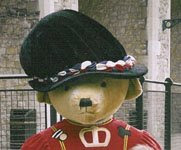
Apparently, Yorkshire pudding first came about, not surprisingly, in Yorkshire, in Victorian times when meat was scarce and people were poor. Puds were served as a first course to fill people up. Today, things are a little better, and nothing is better than a slice of rare beef with a Yorkshire pud. Yum, yum! What a combination. Here’s a surefire way to bake the perfect Yorkshire Pudding.
First off, equipment. The last post showed three pudding pans; the best of these is the one with shallow oval bottoms (the one from Mummy-in-Law). If these pans cannot be found, try small cupcake Pyrex glass containers. Alternatively, you could use a single roasting or pie pan, which will produce one large pudding. This looks quite spectacular, but I feel individual puddings are more fun and you get more crispy bits.
Yorkshire pudding is essentially a batter recipe. People add things like parsley, and thyme and rosemary, extra pepper, even bacon. Jacques Pepin adds leeks. I’ve tried all these additional ingredients and, personally, I feel none add a hill of beans of difference.
The key ingredient is the type of fat you use. The best puddings are made in beef fat, ideally rendered from your Sunday rib roast. But standing rib roast is a big treat in the Prodigal household, so for a non-holidays feast, we use eye of round, a lean cut with very little fat. So I conserve fat from previous meals. Let me explain.
If you’re having a steak or even a stew, just trim the fat, and wrap and freeze it. When you have a bit of time, render your collected bits of fat in a little water. You’ll need about a teaspoonful of fat per individual pudding dish, and what you don’t use can be safely re-frozen (as it’s now cooked). Alternatively, rendered goose or duck fat is delicious too. The key thing is: these fats have loads of flavor and can take high cooking temperatures.
Prodigal Puddings
This recipe makes eight individual puddings. In the Prodigal household, we are only three, but some of us love a second pud. And so will you! If you have leftovers, worry not––cold puds are great topped with your favorite jam as a breakfast treat.
Right, let’s get to it. Before you do anything else, prep your pudding (or Pyrex) pans with a teaspoon of fat in each hollow.
Now make the batter. Combine 3/4 cup of all-purpose flour, a pinch of salt, a cup milk, and a 1/4 cup of water in a glass bowl. We use skimmed milk but use whatever milk you have on hand. Now, add two or three eggs, one at a time. Whisk by hand or machine until everything is nicely incorporated. Then whisk some more. I whisk for the count of sixty. I’m looking for a part-bubbly, fluid mixture. At this point, add some pepper (and other items from above list if you must). Then cover your bowl and put it in the fridge to rest for at least half an hour. Because I get flummoxed when I cook, I’ve been known to get my pudding mixture ready before the meat is even in the oven. It matters not. Just make sure the mixture sits for at least half an hour.
When your roast beast is ready, remove it from the oven, cover, and let it rest. Now crank up the oven to 450 F degrees. Put your pudding pans, with fat in the hollows, at the back of the oven. When the temperature reaches 450, check your pans. The fat should be smoky hot. If not, wait another minute or two. Close oven. Remove pudding mixture from the fridge and whisk quickly to re-incorporate everything. Have a small ladle handy; I sometimes use a 1/4 cup measure.
The next step is important.
Open the oven and slide out the rack. Don’t removes the pans. Ladle the batter mixture into the hot pans right in the oven. Work as briskly as you can. When the pans are filled, gently push back the rack and close the oven. After 15 minutes, reduce oven temp to 425 and cook puds for another fifteen minutes. Then reduce oven temp. to 350. Within the next 10 minutes, depending on the ferocity of your oven, your puds will be baked and ready. Do check, during this final ten minutes, if the puds slide freely in the pans, they’re done.
I switch off the oven at this point and let the puddings be while I carve the meat. I spread the meat on as large platter then garnish with the puds. There is no more sublime a sight! Traditionally, we anoint the hollow of our puddings with gravy. Or not. Either way is lovely.
Enjoy your Yorkshire Puddings!
 It has been brought to our attention that the teas we mentioned in a perfect cup of rosie lea may be hard to find in some parts of the country. Therefore, in honor of the Prodigal Birthday, and to ensure everyone in the United States (sorry!) an opportunity to try my favorite blend, we are giving away a packet of Typhoo teabags and a tin of Twinings Earl Grey loose tea.
It has been brought to our attention that the teas we mentioned in a perfect cup of rosie lea may be hard to find in some parts of the country. Therefore, in honor of the Prodigal Birthday, and to ensure everyone in the United States (sorry!) an opportunity to try my favorite blend, we are giving away a packet of Typhoo teabags and a tin of Twinings Earl Grey loose tea.




























